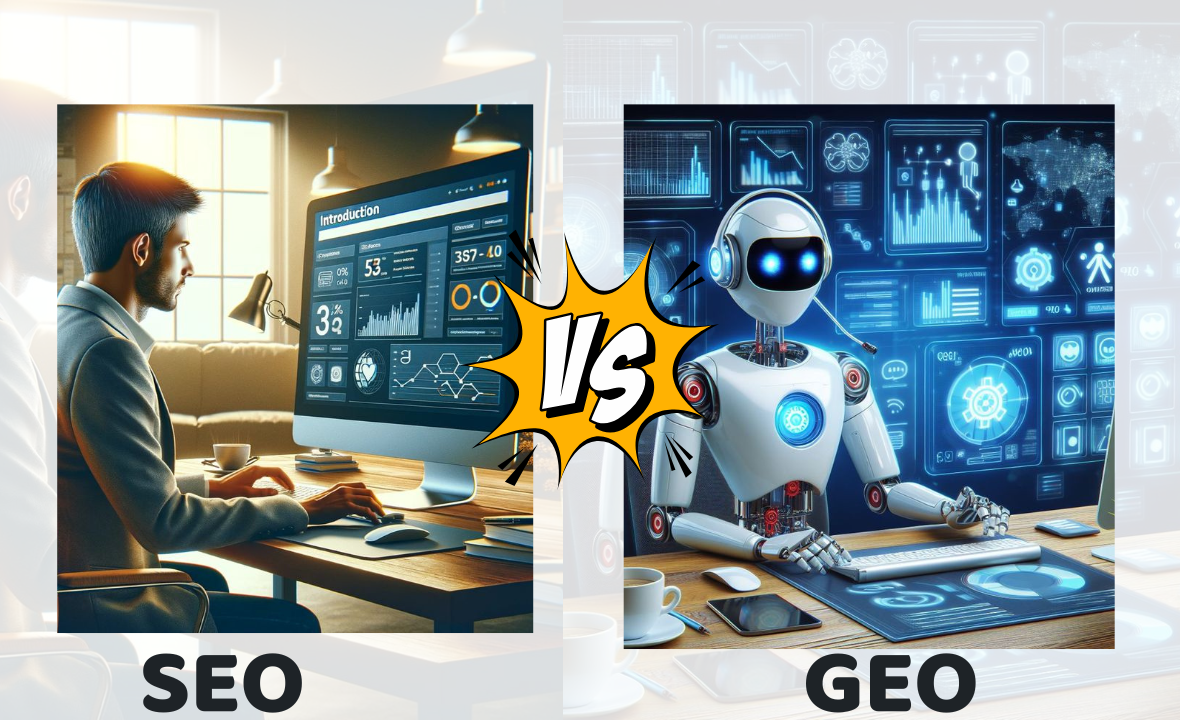
SEO vs GEO: What’s the Difference, and Why Is It Important?
Digital marketing is the key to unlocking your brand’s potential in today’s online world, driving visibility and growth like never before. At its core, it includes strategies like Search Engine Optimization (SEO), Generative Engine Optimization (GEO), Pay-Per-Click (PPC) advertising, social media marketing (SMM), content marketing, and Web Development, each playing a unique role in connecting with your audience.
Maskoid Technology provides digital marketing services tailored to boost your online presence, including expert social media marketing and PPC services. Today, we’ll dive into the differences between SEO vs GEO, why they matter, and how Maskoid Technology’s cutting-edge solutions can help your business thrive in the ever-evolving digital landscape.
What is SEO?
Key components of SEO include:
- Keyword Optimization: Researching and using high-intent keywords that are in line with user queries.
- On-Page SEO: Optimizing meta tags, headings, alongwith content structure to improve crawlability.
- Technical SEO: Making sure users experience rapid page load speeds, mobile optimization, and index optimization.
- Link Building: The genius of obtaining quality backlinks to gain authority.
- User Experience: Produce interesting, relevant information that lowers bounce rate and time on page.
What is GEO?
Generative Engine Optimization is a new idea that was formalized in 2023 and is aimed at optimizing content for artificial intelligence-powered search engines, or generative engines.
These platforms include Google’s Search Generative Experience (SGE), ChatGPT, Perplexity, and Microsoft Copilot, which don’t just give a series of links but create a combination of information and source links to create conversational, context-rich responses. The trajectory of GEO is to make the information AI-friendly and cited or featured in these synthesized answers.
Key GEO strategies include:
- Content Clarity: Utilise simple, direct language along with clear headings and concise points to facilitate AI parsing.
- Citation Optimization: Including authoritative sources, quotations, and statistics to boost trustworthiness.
- Contextual Relevance: Timing out content to each user’s intent to answer particular questions in detail.
- Structured Data: Implementing schema markup helps AI understand the relationships between different pieces of information.
- Multimodal Content: Incorporating images, videos, or infographics to enhance AI-generated responses.
SEO vs GEO: Key Differences
| Aspect | SEO | GEO |
|---|---|---|
| Targeted Search Engines | Focuses on traditional search engines like Google, Bing, and Yahoo, which display ranked lists of links. | Focus on AI-powered generative engines such as Google SGE, ChatGPT, and Perplexity, which produce conversational responses. |
| Content Structure | Emphasizes keyword density, meta tags, and backlinks to optimize individual pages for ranking. | Prioritizes clear, modular content (e.g., FAQs, summaries) that AI can easily extract and integrate into responses. |
| User Interaction | Aims to drive users to a website through clicks, focusing on research-driven queries. | Provides direct answers within AI responses, catering to users seeking quick, actionable insights. |
| Success Metrics | Tracks keyword rankings, click-through rates, and time on page. | Measures citation frequency in AI responses and relevance to user intent. |
| Content Strategy Flexibility | Relies on universal tactics like keyword optimization across content types. | Uses domain-specific strategies, such as authoritative language for history or data for legal topics. |
Why Are SEO and GEO Important?
Both Search Engine Optimization and Generative Engine Optimization are critical for maintaining a competitive edge in 2025’s digital landscape. Here’s why:
Evolving Search Behaviour: Traditional search is still the mainstay, and Google takes over 90% of the world’s search market. AI-powered platforms are gaining traction, with Google’s AI Overviews projected to reach 1 billion users by the end of 2024. Optimizing for both is guaranteed to provide maximum visibility.
Complementary Strategies: SEO gives you traffic to your site, and GEO presents your information as a credible source for AI responses, hence elevating brand authority. When combined, they form a strong digital footprint.
User Intent Focus: Both are concerned with user intent, and GEO takes this further by predicting subsequent questions and offering complete answers to increase the experience of the users.
Future-Proofing: As generative AI disrupts search, Generative Engine Optimization keeps your information up to date. Neglecting GEO may make a company lose visibility to competitors that act early.
Latest Updates in SEO and GEO for 2025
SEO Updates
- E-E-A-T Emphasis: Experience, Expertise, Authoritativeness, and Trustworthiness priorities are highest to Google’s liking. It is necessary to avoid penalties, hence the need for high-quality, human-generated content.
- Mobile-First Indexing: Technical SEO has to focus on responsive design and speedy loading times when mobile searches are ruling the roost.
- Semantic SEO: Optimizing for entities and context, it is now closer to Generative Engine Optimization principles.
GEO Updates
- AI Overview Citations: A 2024 SEO Clarity analysis found that 99.5% of Google AI Overview citations match the top 10 SERP results, emphasizing the overlap between both.
- Domain-Specific Strategies: Research shows that GEO tactics vary by topic. For example, historical content benefits from authoritative language, while legal content gains from statistics.
- New Tools: Tools like HubSpot’s AI Search Grader and Surfer SEO now analyze Generative Engine Optimization performance, offering insights into AI citation frequency and information gaps.
How to Integrate Both for Maximum Impact?
To boost rankings and engage readers, combine both strategies:
- Create Information-Intensive Content: Write accurate, engaging information that addresses user intent for both human readers and AI algorithms.
- Use Structured Data: Use schema markup to make your context easier for search engines and AI to decode.
- Optimize for Clarity: Use less, well-formed headings, bullets, and summary text to attract AI and enhance SEO readability.
- Incorporate Citations and Statistics: Increase Generative Engine Optimization visibility through the use of authoritative sources and data, as well as increase SEO credibility.
- Monitor Performance: Monitor SEO metrics (keyword ranking, etc) and GEO USE metrics (AI citations, etc) to find ways to improve your strategy.
Conclusion
Search Engine Optimization (SEO) and Generative Engine Optimization (GEO) are not opponents, but very strong friends that address different aspects of the modern digital marketing environment. SEO makes sure your content glitters on a traditional search engine result page, produces organic traffic, while GEO places your brand as a reliable voice in AI-generated responses, enhances authority, and maximizes reach.
By mastering both, with the help of Maskoid Technology’s expert digital marketing services like social media marketing and PPC, you can future-proof your online presence, climb search rankings, and deliver valuable content to your audience. As AI-driven search grows in 2025, leveraging SEO and GEO with Maskoid Technology will keep your brand ahead in the competitive digital world.

















